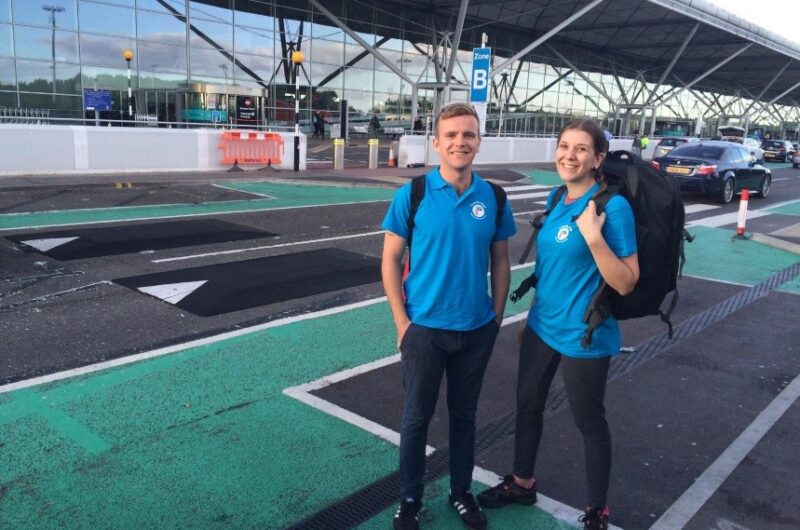23RD SEPTEMBER 2018
This blog was written by long term volunteers and nurses, Livi Rees and Stuart Tuckwood. Livi and Stuart spent 6 months during 2018 – 2019 in Yangon as part of the Cambridge-Yangon Trauma Intervention Partnership.
By Stuart Tuckwood
On Saturday evening Livi and myself touched down in Yangon, Myanmar, to begin a six-month placement in the intensive care units at Yangon General Hospital. Both us have travelled far from our normal place of work, Addenbrooke’s Hospital in Cambridge, where we work for the NHS in critical care. In our day to day roles Livi is an ITU nurse based in the neuro critical-care unit and I work as a specialist nurse in the Rapid Response Team across the hospital.
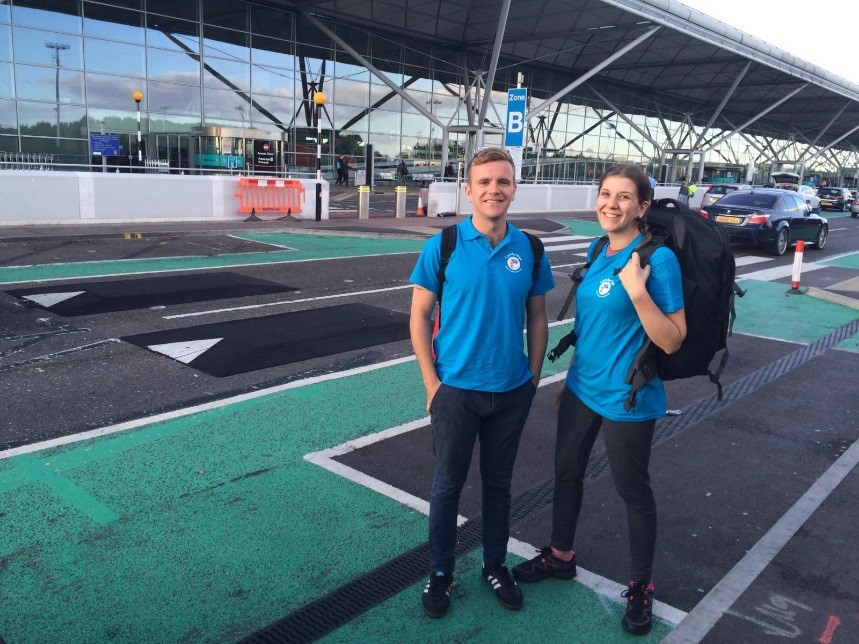
We were very soon aware of how exciting and beautiful place Yangon would be to work in, as we were driven through the traffic whilst the sunset painted the clouds red across the rivers and delta outside the city. For the moment we are based in downtown Yangon, a crowded and bustling grid close to the river at the south of Yangon. Everything around is colourful and bright, the shopfronts, marketstalls and clothes of the crowds on the street which often include wandering monks. The heat and humidity are intense. Whilst struggling to recover from the fatigue of the journey we hit the streets to explore the city. We slogged through the midday heat to see some of the city’s famous sites including the Sule Pagoda, a golden Buddhist temple in the middle of a busy roundabout, and the city’s independence monument in Maha Bandoola Park.
In the evening we continued getting to grips with the local cuisine, trying hot and sour fried bean curd and steamed fish in lemon. Monday morning and a doctor from Yangon General was kind enough to collect us and take us to the intensive care units where we will be based. Yangon General Hospital is a grand, Victorian style red brick building occupying several blocks in downtown Yangon. The Intensive Care Units comprises several rooms in the centre with 20 beds for the sickest patients who require the closest attention. Some are admitted following trauma such as road accidents, whilst others are sick because of diseases and conditions which we are less accustomed to treating, such as tetanus or snake bites.
We were welcomed onto the unit on the first day by several of the intensive care consultants and the nurse in charge of the unit, who greeted us warmly and showed us around. The clinicians working on the units are evidently highly skilled, knowledgeable and enthusiastic, this much is obvious very quickly, whilst they may not have many of the resources we do in the NHS in the UK. We spent several hours with the doctors and nurses on their units, familiarising ourselves with the care given and observing their practice.
Later, in the afternoon we stopped to pick up local phones for use whilst over here. Acclimatising to life in a new country and culture can be difficult, adjusting to a different working environment in healthcare tougher still. Working out where and how we can be of most use will undoubtedly be challenging, though I feel there are many positive signs from our first days here. The strong partnerships and relationships built up between clinicians in Yangon and Cambridge mean there is a lot of goodwill and enthusiasm to build upon and we’re very hopeful we will be able to do that.
The next section is written by Livi Rees.
One week on from our arrival in Yangon the city is already starting to feel like home, helped by our move into the flat that will house us for the remainder of our stay. We are becoming more familiar with the downtown area of the city, and are beginning to navigate by the various restaurants and pagodas we have visited so far and of course by our central landmark, the Yangon General Hospital.
We have spent this week in the hospital observing the work of the nurses and doctors on the unit, attending ward rounds and making notes about potential ideas for projects we could implement during our time here. This week around a quarter of the patients on the intensive care unit have been trauma patients. Interestingly the classification of trauma patients here also includes snake bites and tetanus patients, and we are keen to learn more from the team here about the management of these conditions we are unlikely to see in the UK.

The remainder of the patients on the ICU this week have presented with conditions similar to those we see in our intensive care population in the UK such as [Stuart’s bed in our flat] respiratory failure, sepsis and post cardiac arrest. Another large part of our week has been meeting with other volunteers working on projects in Yangon, and with useful contacts within the hospital and the University of Medicine here.
On Thursday I was invited to visit the Neuro Intensive Care at Yangon General Hospital, which was particularly interesting for me as this is my specialty in the UK. The Neuro ICU consists of four beds for ventilated patients and two for level 2 patients, with a similar set up to the general ICU in terms of families taking responsibility for the patient’s personal care. The head consultant who was taking us around showed me their folder of guidelines, page one being the Addenbrooke’s Hospital Neuro Critical Care Unit’s protocol for the management of intracranial pressure, which made me feel very proud and a tiny bit homesick for my unit!
This week we also enrolled for a course of Burmese language classes and had our first class on Thursday. Although the grammar of the language is relatively simple, our biggest hurdle will doubtlessly be the pronunciation as there are four tones in the language and a plethora of words where a subtle change in tone or enunciation can result in wildly different meanings. No wonder our efforts so far to read aloud from the phrasebook have been met with confusion and amusement! The greatest motivating factor however is the reaction when you do say something right, I have never travelled to any country where such a small amount of the language can go such a long way.
So far our impressions of Yangon have been extremely positive. We have been warmly welcomed by the staff in the hospital and the other volunteers we have met have all been very friendly. Next week we are hoping to meet some more important figures within Yangon General Hospital and present our first ideas for projects to implement in the ICU.
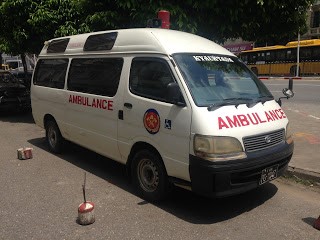
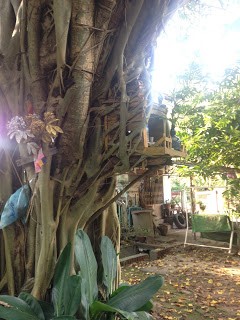
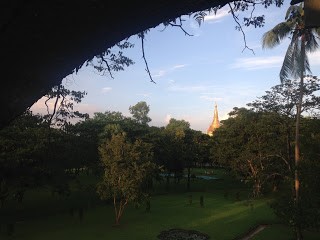
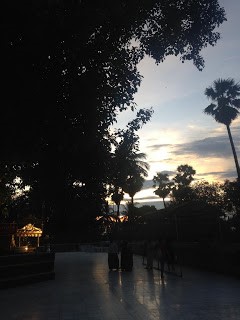

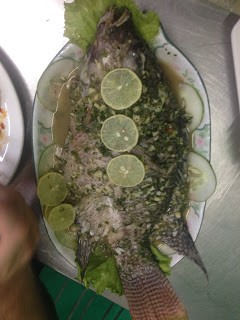
- Myanmar has no national ambulance service, but ambulances are a common sight on the streets around the hospital, often stuck in the traffic with sirens blazing making a slow journey towards the hospital.
- Little shrines line many of the streets of Yangon, this one has been here for so long it has become part of nature itself.
- A view of the Swegadon Pagoda peeking through the trees, taken from the bridge in People’s Park.
- A beautiful Myanmar sunset in the Swegadon complex.
- The Swegadon is surrounded by smaller temples and shrines, and has several bodhi trees, which are sacred in Buddhism as they are said to be the type Buddha was sat under when he achieved enlightenment.
- Delicious steamed fish with lemon
Return to blogs

